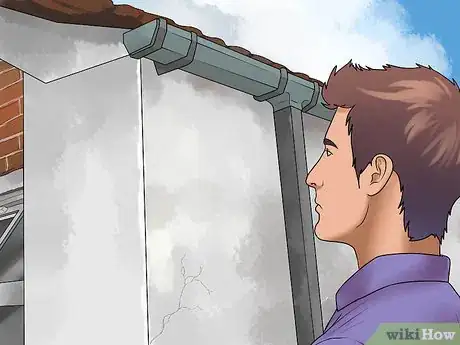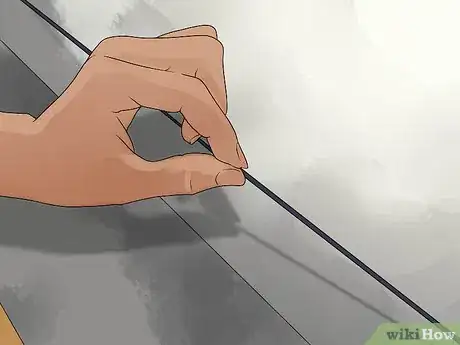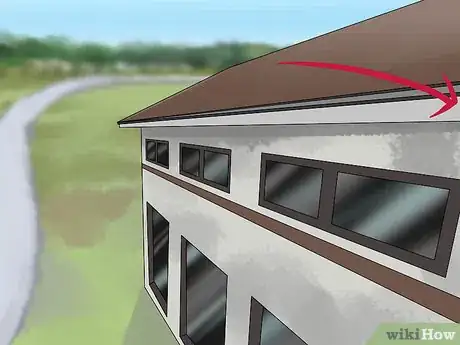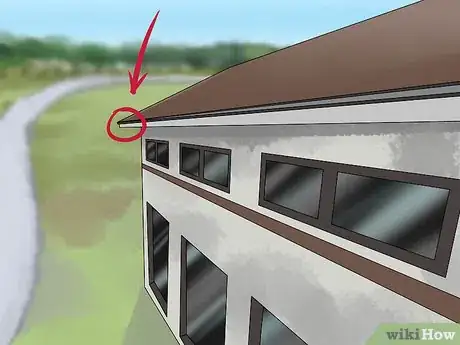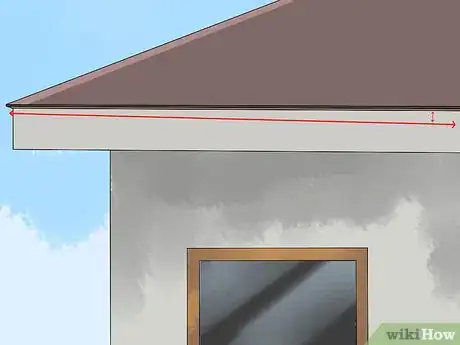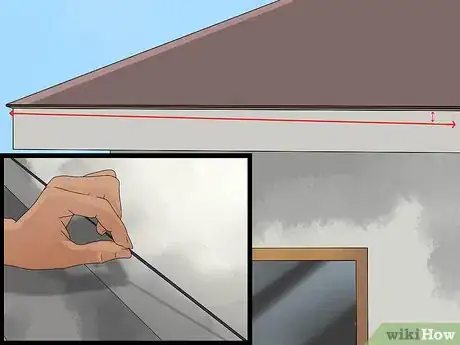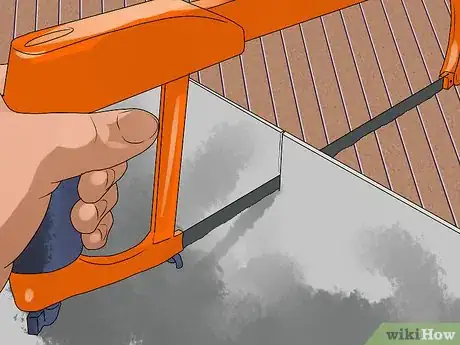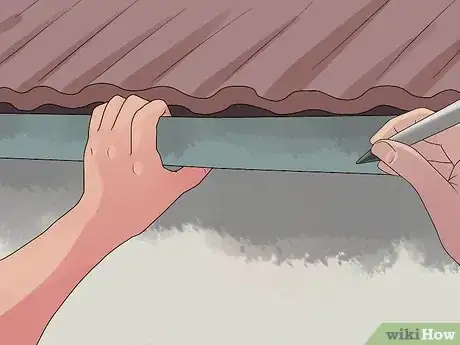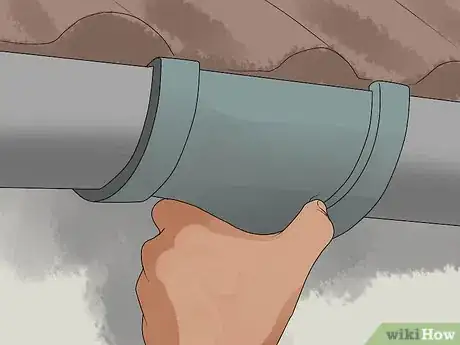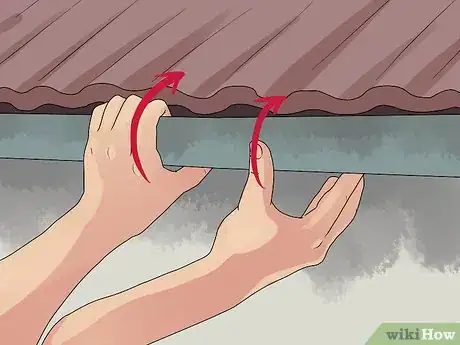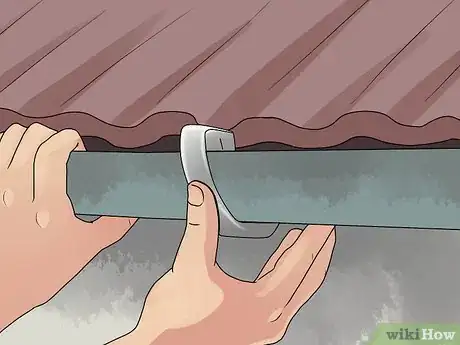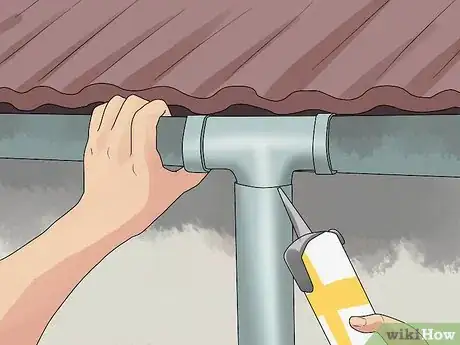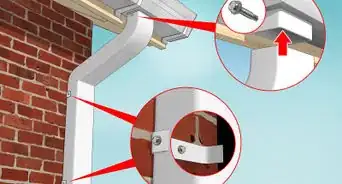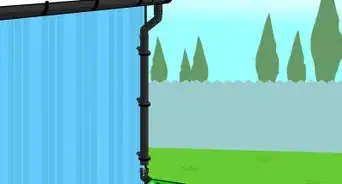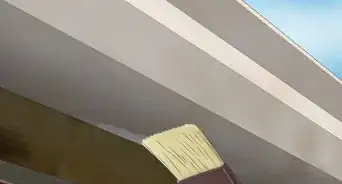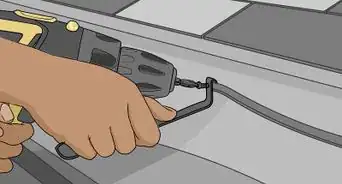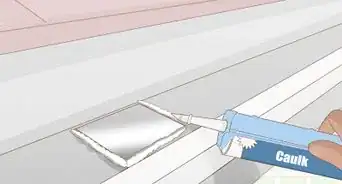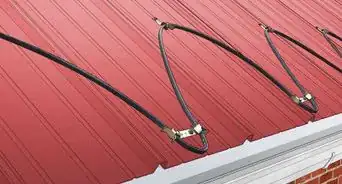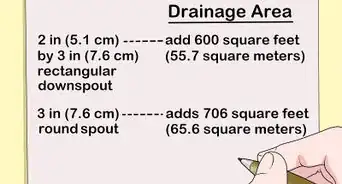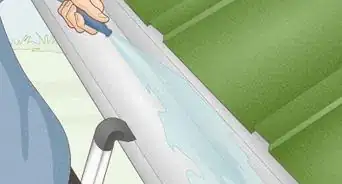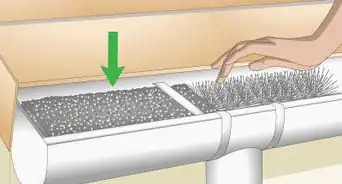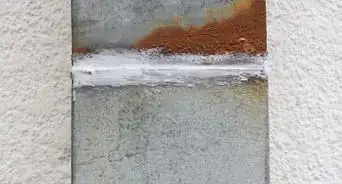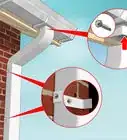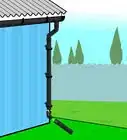This article was co-authored by Ryaan Tuttle. Ryaan Tuttle is a Home Improvement Specialist and the CEO of Best Handyman, Inc. in Boston, Massachusetts. With over 17 years of experience, he specializes in building home service businesses, focusing on creating scalable and efficient brands. With the help of his global team, the companies have achieved over 10+ million in sales and received recognition through magazine features, and enjoy partnerships with wikiHow and Jobber field service software. Boston Magazine and LocalBest.com have named Best Handyman Boston the Best Handyman in Boston. Ryaan holds Construction Supervisor and Home Improvement Contractor Licenses.
There are 12 references cited in this article, which can be found at the bottom of the page.
This article has been viewed 139,817 times.
Rain gutters and downspouts are essential tools that are used to divert and carry rainwater away from the foundation of your house. They help to prevent soil erosion, damage to siding, and basement leaks. It is essential that gutters are measured, pitched, and installed correctly in order to function properly. Gutter installation is a job that many homeowners can tackle on their own with a little effort and the proper tools. Read the article below for instructions on how to install gutters.
Steps
Getting Started
-
1Calculate and purchase at least the total length of gutters needed, as well as the necessary downspouts and attachment brackets.[1] Gutters should be attached to the fascia and run the entire length of the roof, ending with a downspout. If a gutter run will measure longer than 40 feet (12 m), the gutter should be positioned to pitch down from the middle, aimed toward a downspout at each end. A fascia bracket will be attached to every other rafter tail, or approximately every 32 inches (81 cm).[2]
- Depending on the type of gutters you want, expect to pay anywhere from $2 to $6 per linear foot for aluminum gutters. Copper gutters could run as much as $20 per linear foot.[3]
- Expect to pay approximately $2 per linear foot for downspouts, and $6 to $10 each for the brackets that attach the gutters to the fascia.[4]
-
2Inspect the fascia and soffit for any rot or decay before moving on to installation. What good will installation be if the fascia holding your gutters up rots away? To inspect the fascia, poke at the ends of fascia boards, or where two ends of fascia boards meet. If it feels spongy or compromised, you may want to consider replacing the fascia before moving on.[5]
- Think about replacing the fascia with more resistant material, or just sticking with wood.[6]
- If you believe the rotting is caused by excessive moisture due to ineffective gutters, then wood might acceptable. (You are going to install working gutters, after all).
- If you believe the rot to be caused by other factors, consider choosing a material like aluminum or vinyl that withstands the elements a bit better than wood.
- Think about replacing the fascia with more resistant material, or just sticking with wood.[6]
Planning the Slope of the Gutters
-
1Measure and snap a layout line using a chalk line. You want your gutters to work properly, and in order for them to do that, they need to have a slight downward angle to feed any running water toward the downspout.
- Longer gutters (35 feet and longer) will slope from the center to each end. They will start at the same height in the middle and tilt downward to the edges, ending at the same point.
- Shorter gutters should tilt from one end to the other. They should start at a high point and end at a lower point.
-
2Locate the starting point, or highest point, of the gutter run. If your fascia board is longer than 35 feet (10.6 m), your starting point will be in the center of the fascia board. If it's shorter than 35 feet (10.7 m), your gutter will run from one end to the other.[7]
- Mark the high point on the fascia, 1.25 inches (3.175 cm) below the roof flashing with a piece of chalk.
-
3Then, locate the ending point, or the downspout location, of the gutter run. This will be at the corner of a fascia board, and may include one downspout being fed by two different gutters.
-
4Find the end point of the gutter run by using a 1/2-inch (.635 cm) downward slope. Starting at your high point, move down 1/2-inch for every 10 feet (3 m) of gutter.[8]
- For example, if you're working on a 25 foot (7.6 m) fascia board, your end point will be roughly 1-1/4 inch below your high point.
-
5Snap a chalk line between the high and low points. Use a level or a measuring stick to try to get an even line. This will be a guidepost for your gutters, so it helps to be precise.
Sizing, Cutting, and Installing the Gutters
-
1Cut the gutters to size. Use a hacksaw, or heavy duty tin snips to cut the gutter at the appropriate measurement. You may need to cut your gutters at a 45 degree angle if two gutters meet at a corner.[9]
-
2Attach the gutter brackets on every other rafter tail.[10] Locate each rafter tail — usually spaced every 16 inches (40.6 cm) apart — by looking for their signature nail heads. After you've marked the location of each one, drill pilot holes along every other rafter tail to make installation of the brackets easier.
- Brackets will either snap onto the gutters or will be mounted into the face board first, depending on the type of gutters you purchase. Review the manufacturer's recommendations for your particular type of gutter.
-
3Mark the location for the downspout opening on the gutter. Use a jigsaw to cut a square opening at the appropriate place in the gutter.
-
4Attach the downspout connector and end cap to the gutter using silicone sealant and short metal screws. An end cap should be used on any open-ended run of gutter.
-
5Mount the gutters. Slip the gutter into place by tilting it upward until its back end fits into place at the top of the bracket. The gutter should either snap into place or be reasonably snug.[11]
- A bracket should be mounted to the face-board every 18 to 24 inches (45 to 60 cm). Use a stainless steel lag screw long enough to penetrate the face-board at least 2 inches (5 cm).
-
6Wrap a thin aluminum strip around the underside of each gutter corner, riveting it into place. To keep water from leaking through small cracks or openings at conjoined corners, insulate the aluminum strip further using waterproof caulk.
- This aluminum strip can be spray-painted ahead of time to blend in seamlessly with the color of the gutter.
- Make the strip long enough to extend an inch or two beyond the top of the gutter. Cut a triangular shape into the top of the extending strip, and then fold each corner or the strip over onto the top of the gutter, creating a clean look.
-
7Attach the downspout to the gutters via the downspout connector. Make sure that the tapered end of the downspout is facing down and aimed in the appropriate direction.[12]
- To get the downspout to connect with the outlet tube, crimp the downspout with some pliers.
- Fasten the downspout to the gutters and the downspout to the outlet tube either with pop rivets or the appropriate screws.
-
8Seal any gutter connection seams with a heavy bead of sealant and allow to dry overnight.
Expert Q&A
-
QuestionWhich type of silicone should I use?
 Ryaan TuttleRyaan Tuttle is a Home Improvement Specialist and the CEO of Best Handyman, Inc. in Boston, Massachusetts. With over 17 years of experience, he specializes in building home service businesses, focusing on creating scalable and efficient brands. With the help of his global team, the companies have achieved over 10+ million in sales and received recognition through magazine features, and enjoy partnerships with wikiHow and Jobber field service software. Boston Magazine and LocalBest.com have named Best Handyman Boston the Best Handyman in Boston. Ryaan holds Construction Supervisor and Home Improvement Contractor Licenses.
Ryaan TuttleRyaan Tuttle is a Home Improvement Specialist and the CEO of Best Handyman, Inc. in Boston, Massachusetts. With over 17 years of experience, he specializes in building home service businesses, focusing on creating scalable and efficient brands. With the help of his global team, the companies have achieved over 10+ million in sales and received recognition through magazine features, and enjoy partnerships with wikiHow and Jobber field service software. Boston Magazine and LocalBest.com have named Best Handyman Boston the Best Handyman in Boston. Ryaan holds Construction Supervisor and Home Improvement Contractor Licenses.
Home Improvement Specialist Use 100% silicone. It is suitable for the exterior. Many people use kitchen and bath silicone for outside that is not correct.
Use 100% silicone. It is suitable for the exterior. Many people use kitchen and bath silicone for outside that is not correct. -
QuestionWhat is the benefit of sealing the gap between the fascia board and the gutter?
 Ryaan TuttleRyaan Tuttle is a Home Improvement Specialist and the CEO of Best Handyman, Inc. in Boston, Massachusetts. With over 17 years of experience, he specializes in building home service businesses, focusing on creating scalable and efficient brands. With the help of his global team, the companies have achieved over 10+ million in sales and received recognition through magazine features, and enjoy partnerships with wikiHow and Jobber field service software. Boston Magazine and LocalBest.com have named Best Handyman Boston the Best Handyman in Boston. Ryaan holds Construction Supervisor and Home Improvement Contractor Licenses.
Ryaan TuttleRyaan Tuttle is a Home Improvement Specialist and the CEO of Best Handyman, Inc. in Boston, Massachusetts. With over 17 years of experience, he specializes in building home service businesses, focusing on creating scalable and efficient brands. With the help of his global team, the companies have achieved over 10+ million in sales and received recognition through magazine features, and enjoy partnerships with wikiHow and Jobber field service software. Boston Magazine and LocalBest.com have named Best Handyman Boston the Best Handyman in Boston. Ryaan holds Construction Supervisor and Home Improvement Contractor Licenses.
Home Improvement Specialist If you seal the gap between the fascia board and the gutter when any water runs onto the facia from the roof, it will not run behind the gutter. It will run into it.
If you seal the gap between the fascia board and the gutter when any water runs onto the facia from the roof, it will not run behind the gutter. It will run into it.
Things You'll Need
- Gutters
- Silicone sealant
- Screwdriver/drill
- Lag screws
- Short screws
- Tin Snips
- Hacksaw
- End caps
- Chalk line
- Measuring tape
- Downspouts
- Downspout connectors
- Fascia brackets
References
- ↑ Barry Zakar. Handyman. Expert Interview. 16 July 2020.
- ↑ https://www.thisoldhouse.com/ideas/how-to-size-gutters-and-downspouts
- ↑ http://www.thisoldhouse.com/toh/how-to/intro/0,,442134,00.html
- ↑ http://www.thisoldhouse.com/toh/how-to/overview/0,,442134,00.html
- ↑ https://www.nytimes.com/2000/11/26/nyregion/home-clinic-making-eaves-inspection-a-routine.html
- ↑ https://www.thisoldhouse.com/how-to/how-to-repair-rotted-soffit
- ↑ https://www.youtube.com/watch?v=aEV1OoGKBpE
- ↑ https://www.youtube.com/watch?v=aEV1OoGKBpE
- ↑ https://extremehowto.com/gutters-downspouts-for-the-diyer/
- ↑ http://www.thisoldhouse.com/toh/how-to/step/0,,442134_318666,00.html
- ↑ https://todayshomeowner.com/video/how-to-install-rain-gutters/
- ↑ https://www.thisoldhouse.com/how-to/how-to-install-rain-gutter
- ↑ Ryaan Tuttle. Home Improvement Specialist. Expert Interview. 13 January 2021.
- ↑ Ryaan Tuttle. Home Improvement Specialist. Expert Interview. 13 January 2021.
- ↑ Ryaan Tuttle. Home Improvement Specialist. Expert Interview. 13 January 2021.
- ↑ Barry Zakar. Handyman. Expert Interview. 16 July 2020.
About This Article
To install gutters, have the gutters slope downward toward the downspout so they work properly. If the fascia board you're installing them on is longer than 35 feet, have the gutters slope from the center to each end. Or, if the fascia board is less than 35 feet long, have the gutter slope from one end of the board to the other. Before you get started, make sure the fascia board doesn't have any rot or decay, and replace it if it does. To learn how to size and cut your gutters before installing them, scroll down!


